Indiana, the Hoosier State, is primarily known for its cornfields and car races, but it’s also home to a remarkable diversity of wildlife. Of this vast array of animals found in Indiana, there are over 160 different caterpillar species. These captivating larvae eventually transform into beautiful butterflies and moths. The caterpillars in Indiana are found in various sizes, shapes, and colors, living in gardens, woodlands, and even in our homes. But don’t let their often bright and captivating appearance fool you.
A surprising number of these species carry toxins that can pose a risk to humans. So, let’s dive in and explore these fascinating insects, learning to appreciate their beauty while also understanding the potential hazards they may present.
1. Buck Moth Caterpillar (Hemileuca maia)
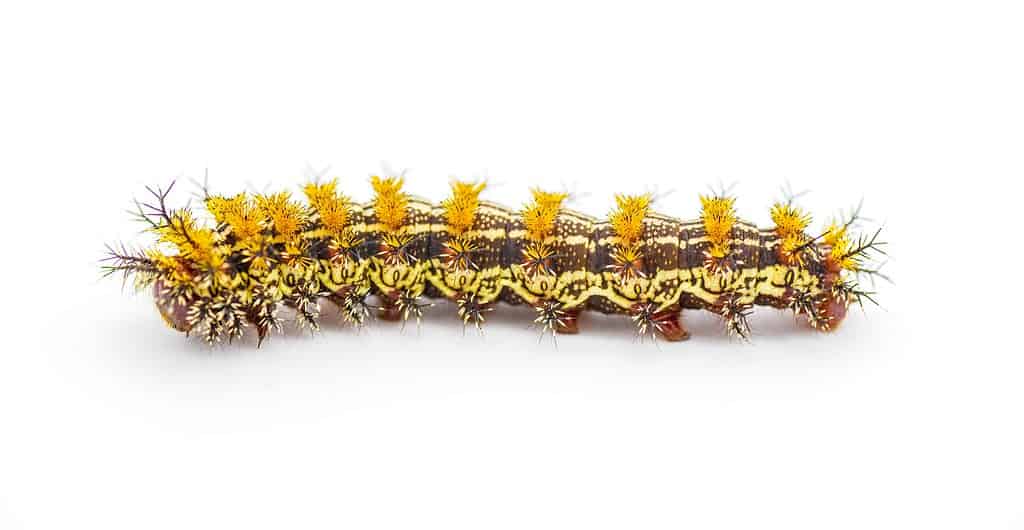
This fuzzy caterpillar in Indiana has poisonous spines that can deliver a painful and irritated sting. So, while they may look harmless, keep your distance from this larva.
©Chase D’animulls/Shutterstock.com
Recognized for its poisonous stings, the caterpillar of the buck moth carries a notorious reputation. Its body can appear in varying colors, such as black or a deep red, and may even feature white speckles. One unique aspect about it is the sharp bristles sprouting from its entire body, which can cause skin irritation, including redness, itching, and discomfort.
Primarily, these caterpillars choose to feed on several varieties of oak trees. In Indiana, they are the easiest to spot in the early summer months, particularly in June.
2. Cabbage Looper (Trichoplusia ni)
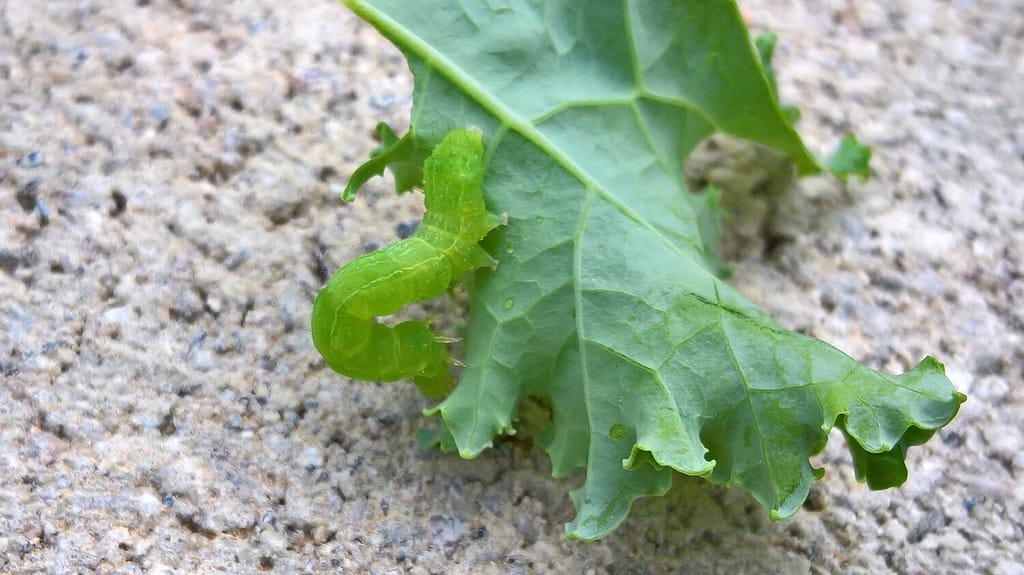
This caterpillar species can easily disguise itself on the leaves of kale, cabbage, broccoli, and other cruciferous plants that it consumes.
©amy71465/Shutterstock.com
The cabbage looper caterpillars are green in color and are easily identifiable by the slender white stripes along their sides and several thin lines on their backs. These caterpillars also display a unique arching movement when they crawl.
As their name suggests, they primarily eat cruciferous plants like cabbage, broccoli, and cauliflower. They can be particularly harmful to these plants, and in large numbers, cabbage loopers can destroy an entire crop.
Luckily cabbage loopers do not possess venomous or poison that is harmful to humans, but they are still considered a pest as they cause extensive damage to crops.
3. Common Buckeye Caterpillar (Junonia coenia)
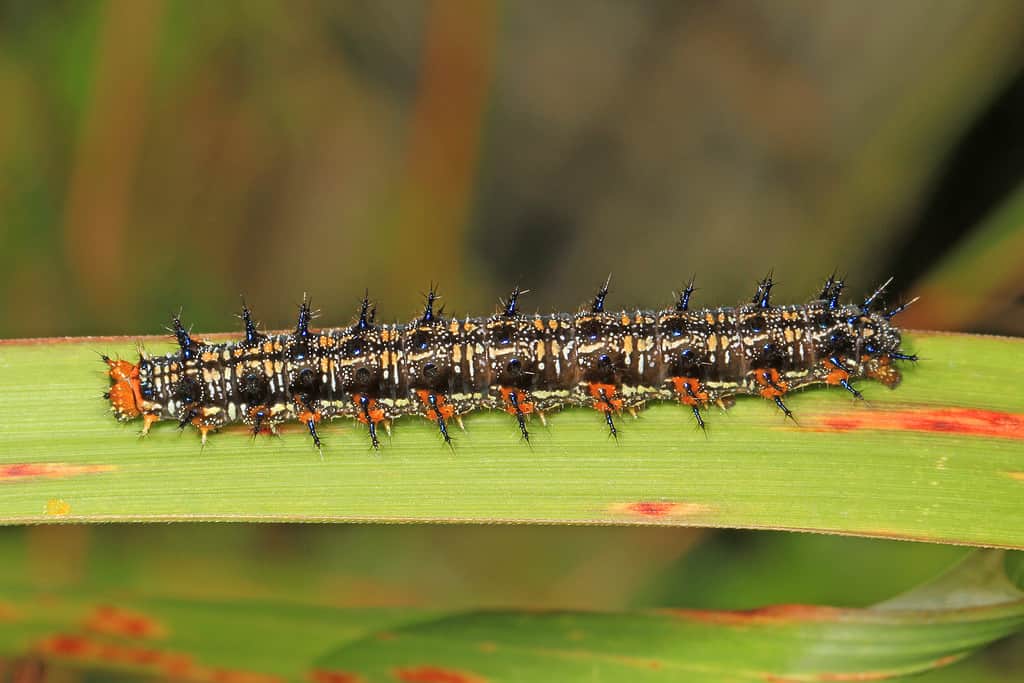
As butterflies, common buckeyes have a beautiful coloration with eyespots on their wings.
©Judy Gallagher / CC BY 2.0 – License
Common buckeye caterpillars have a bluish-black color, decorated with stripes and spots ranging from yellow to cream. They sport multiple metallic, bluish-black, branched spines. This caterpillar also has spines on their sides, sprouting from prominent orange spots.
Buckeye caterpillars are usually lone feeders, predominantly nourishing on plantain weeds and the Gerardia plant, known for its vibrant flowers.
These caterpillars aren’t poisonous. And they undergo a transformation to become one of Indiana’s most captivating butterflies. The buckeye butterfly has beautiful eye-like spots on its wings that it uses to scare off predators.
4. Eastern Tiger Swallowtail Caterpillar (Papilio glaucus)
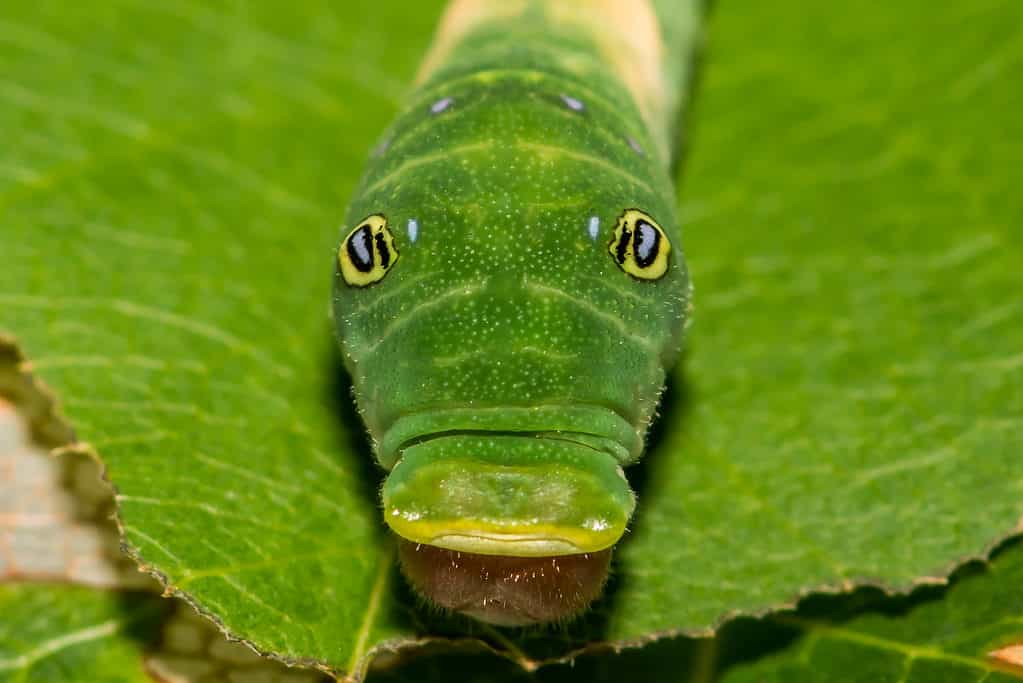
Eastern
tiger
swallowtail caterpillars look like snakes, with large “fake” eye spots on the top of their heads to scare away predators.
©Jay Ondreicka/Shutterstock.com
In their early stages, eastern tiger swallowtail caterpillars sport a brown-and-white color scheme, which evolves as they age.
As they reach maturity, these caterpillars transform into a vivid green color decorated with orange and black false eyespots. These eyespots act as a brilliant defense mechanism, tricking predators into believing the caterpillar is a much larger (and more dangerous) creature than it is in reality!
The diet of eastern tiger swallowtail larvae includes leaves from a variety of trees, such as wild cherry, tulip, and birch. Despite their intimidating appearance, eastern tiger swallowtail caterpillars pose no threat to humans as they’re non-venomous and become splendid butterflies!
5. Fall Webworm (Hyphantria cunea)
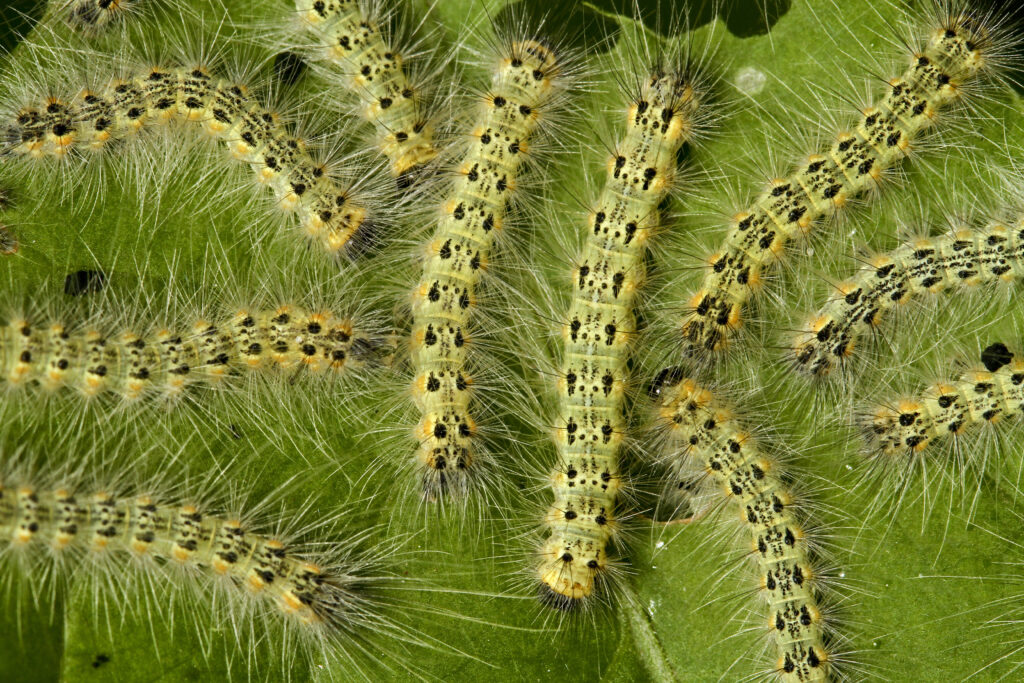
This caterpillar has extremely long hairs protruding from its body, but don’t worry! The fall webworm is not venomous.
©Geza Farkas/Shutterstock.com
Interestingly, fall webworms are sometimes easier to spot in their caterpillar stage than when they’re moths! These creatures exhibit a color spectrum from light green to dark gray, adorned with sparse pale hairs and clusters of long strands.
Their diet is quite versatile, with over 100 species of leafy trees on their menu, including birch, cottonwood, and elm, among others.
They’re harmless to humans and can generally be spotted between summer and fall.
6. Forest Tent Caterpillar (Malacosoma disstria)
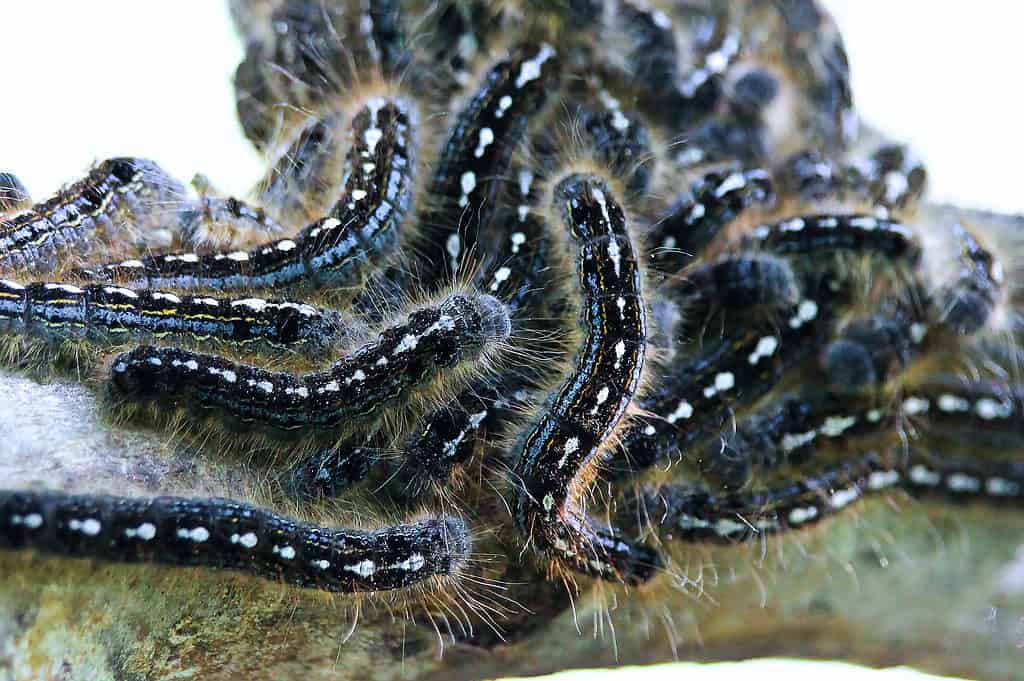
These black and blue caterpillars consume large amounts of tree leaves during the larval stage of their lifecycle.
©Amelia Martin/Shutterstock.com
Fully matured forest tent caterpillars are about two inches long and are predominantly blueish-black in color. You can identify this species by the distinctive series of white, foot-shaped patterns running along their backs. Additionally, the edges of the forest tent caterpillar’s body are very hairy.
Feasting on aspen and other deciduous trees for five to six weeks, they create hardly noticeable silk mats on tree trunks and branches where they gather for rest.
They pose no threat to humans, and eventually, these non-toxic caterpillars metamorphose into buff-brown moths.
7. Giant Leopard Moth Caterpillar (Hypercompe scribonia)
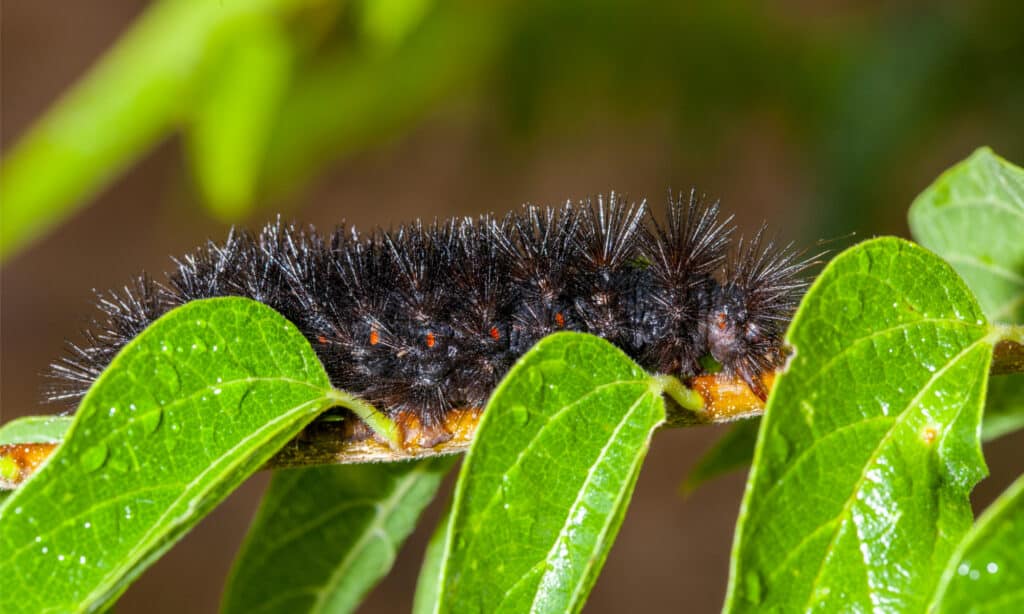
This massive spiky caterpillar is the larva of the giant
leopard
moth. This caterpillar species is commonly found in Indiana.
©iStock.com/Eblis
Mature giant leopard moth caterpillars are predominantly black, with each segment separated by red bands. From each section springs a cluster of stiff, black spikes rooted in brownish nodules.
These caterpillars’ primary food source is leafy plants.
Though mainly active at night, these caterpillars are frequently seen on roads during autumn as they search for suitable spots to hibernate through winter. Despite their formidable appearance, they are not poisonous.
8. Gold Moth Caterpillar (Basilodes pepita)

Another large caterpillar species is the gold moth caterpillar.
©Wilfreda Wiseman/Shutterstock.com
The gold moth caterpillar measures about 1.57 inches in length and sports a vibrant orange hue, with a series of black bands encircling its body. Each side of this caterpillar also features a line of white spots. Its head is a muted shade of orange, while its belly is pale yellow.
As an herbivore, the gold moth caterpillar thrives on the flowers, leaves, seeds, and stems of different plants. They spend most of their caterpillar stage eating and growing to build up the energy for their metamorphosis.
You can typically spot these mature caterpillars from August through October, often associated with regions rich in lowland hardwoods, swamps, and floodplain forests. Despite their striking coloration, they pose no threat.
9. Imperial Moth Caterpillar (Eacles imperialism)

This is one of the largest caterpillar species in Indiana, growing up to five inches long!
©Matt Jeppson/Shutterstock.com
The imperial moth caterpillars ultimately grow into hefty worms, reaching an astonishingly large size of between three to five inches in length. Their color varies from green to brown and sometimes even almost black. The brown variants often have distinctive orange spots.
They relish the leaves of many trees, but pines, oaks, and maples are their preferred dining options.
Typically noticeable in the later parts of summer, these caterpillars carry stinging hairs and barbs, which, while not venomous, can lead to uncomfortable, itchy rashes or even painful stings.
10. Large Tolype Caterpillar (Tolype velleda)
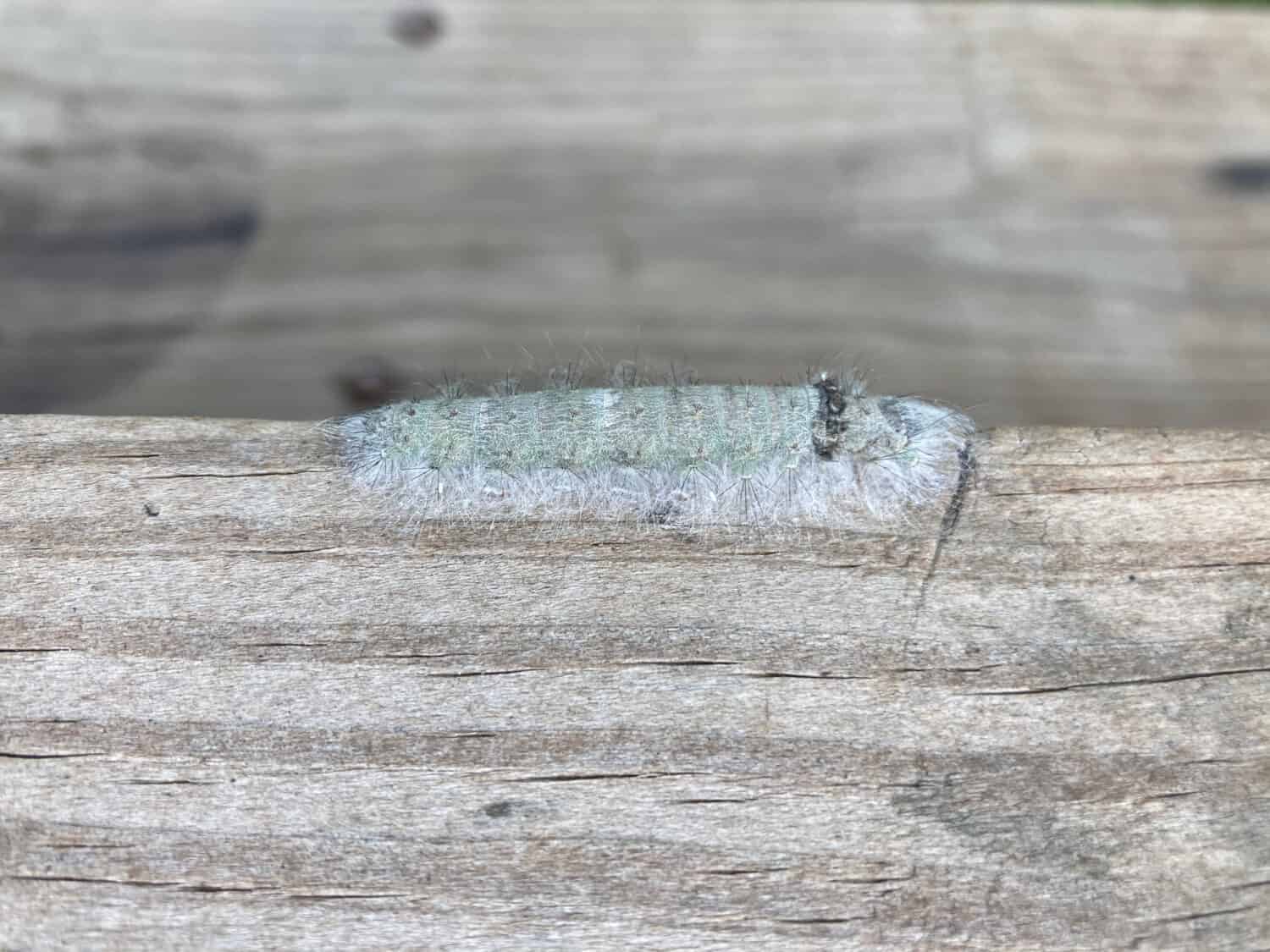
The large tolype moth caterpillar looks like a giant grey mustache!
©B. Kelly Swanson/Shutterstock.com
Caterpillars of the large tolype moth are gray in color and are heavily furred. In their early stages, they feature a unique flap on their pro-legs, which fades away as they grow older.
You can typically spot these larvae during the summer months. Their diet consists of leaves from a variety of broadleaf trees and shrubs.
Although not commonly known, the tolype moth, a type of tussock moth, poses a hidden danger. Its caterpillars are blanketed with sharp spines that can lead to significant skin irritation, proving that they are not as harmless as they may appear.
11. Luna Moth Caterpillar (Actias luna)
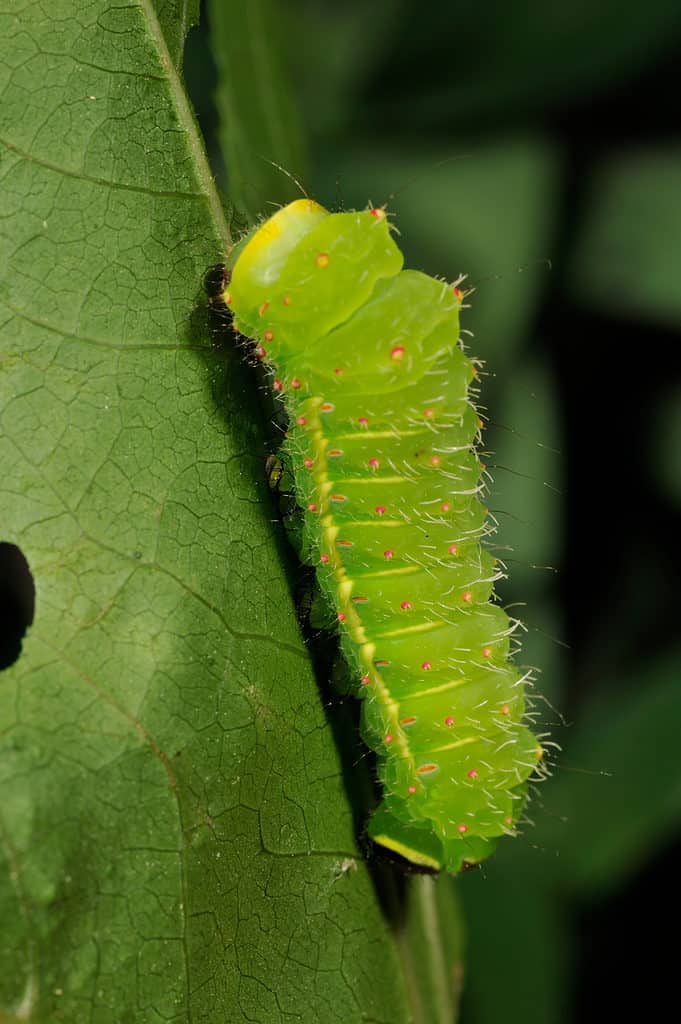
The luna moth caterpillar has a bright green color with small orange spots. Don’t let this bright coloration fool you, though. The luna moth caterpillar is not poisonous.
©Breck P. Kent/Shutterstock.com
With a striking lime green color, the luna moth caterpillar is one of the most recognizable in Indiana. This species is adorned with yellow stripes and reddish-orange spots along their sides.
Luna moth caterpillars thrive on the leaves of various tree types, leading to an herbivorous lifestyle. You can usually find them during the warmer months of spring and summer, crafting their own silk-leaf cocoons for the transformation process.
Despite their striking appearance, there’s no need to fear these caterpillars or their moth forms as they pose no harm to humans.
12. Monarch Caterpillar (Danaus plexippus)

Monarchs are probably the most popular butterfly species in the United States. Due to their migratory patterns, monarch butterflies can live up to 8 months, which is MUCH longer than any other butterfly species.
©iStock.com/CathyKeifer
The caterpillar of the monarch butterfly is one of the most common caterpillars found in Indiana. This species is easy to recognize as both butterflies and caterpillars, boasting a vivid pattern of yellow, black, and white stripes and growing up to two inches long.
Their diet is unique, as they feed exclusively on milkweed plants.
While they pose a danger due to their highly toxic nature, they also hold a sense of awe, transforming into the widely admired monarch butterflies.
13. Monkey Slug Caterpillar (Phobetron hipparchia)
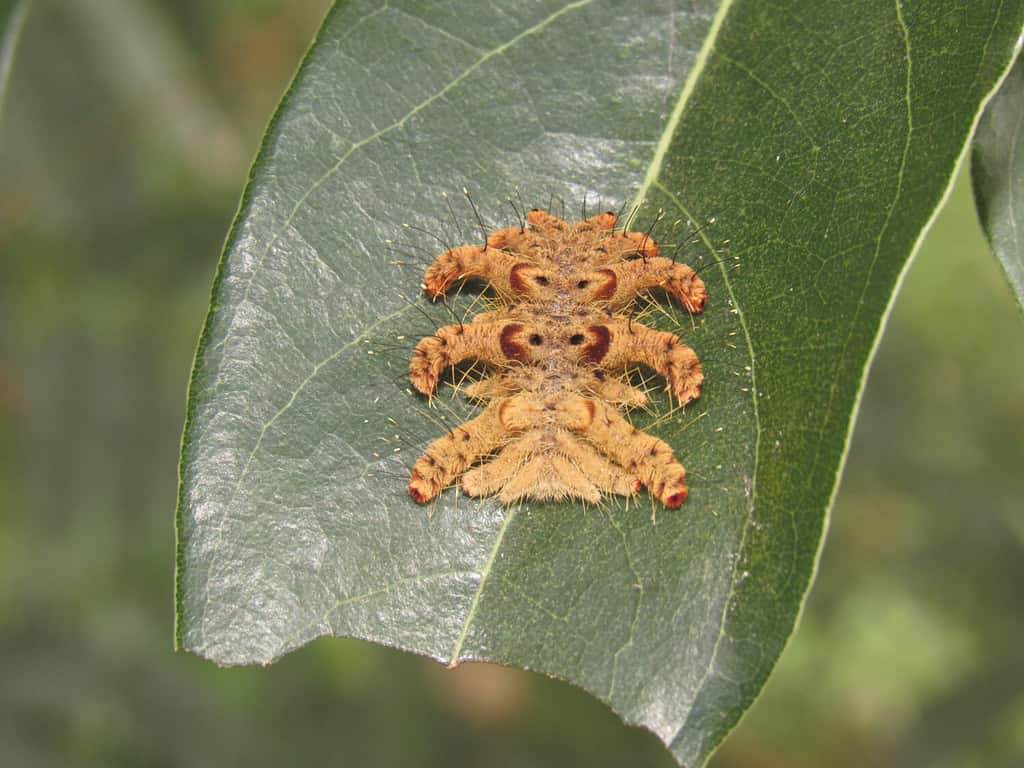
Also called the hag moth, the monkey slug caterpillar is one of the strangest and most recognizable caterpillar species in the world!
©Fabio Ara/Shutterstock.com
The caterpillar of the monkey slug looks nothing like the standard picture of a caterpillar. This extraterrestrial-looking larva bears a striking resemblance to a fuzzy, brown starfish with a slightly stretched shape. This peculiar caterpillar of the oak slug moth is equipped with hairs that sting, and rather than typical prolegs, they have suction-like structures that allow them to move around like slugs.
Feeding on a diverse range of host trees and shrubs, monkey slug caterpillars are also known to munch on fruit trees.
Despite its rather terrifying appearance, the monkey slug caterpillar is generally harmless.
14. Pipevine Swallowtail Caterpillar (Battus philenor)

Pipevine swallowtail caterpillars are black with orange spikes. They are not venomous, but if accidentally ingested, they can be harmful to humans and pets.
©Sundry Photography/Shutterstock.com
The pipevine swallowtail caterpillar’ black body is adorned with red spines and spots along its back. These markings are a defense mechanism to make it appear unappetizing to potential predators.
Often known as blue swallowtails, these caterpillars have a specific palate, favoring the leaves of birthworts and Dutchman’s pipes as their sole source of nourishment.
Packing a poisonous punch, both the caterpillar and its adult form are harmful if ingested. Despite their toxicity, these black caterpillars become stunningly beautiful butterflies.
15. Puss Caterpillar (Megalopyge opercularis)

Another very recognizable caterpillar species in Indiana is the extremely fuzzy puss caterpillar.
©Chase D’animulls/Shutterstock.com
The puss caterpillar is one of the strangest caterpillars in Indiana. Clothed in a furry exterior of thick, tapered, tan to grayish-white hairs, this species grows to approximately an inch long.
Known alternatively as the southern flannel moth caterpillar, it feeds on the leaves of diverse trees and shrubs, including pecan, oak, and apple trees, especially active in the late summer to early fall period.
Beneath its soft exterior, the puss caterpillar conceals venomous spikes. These spikes can trigger severe pain and produce blisters that persist for several weeks. So, if you spot this unique caterpillar in the wild in Indiana, keep your distance!
16. Saddleback Caterpillar (Acharia stimulea)
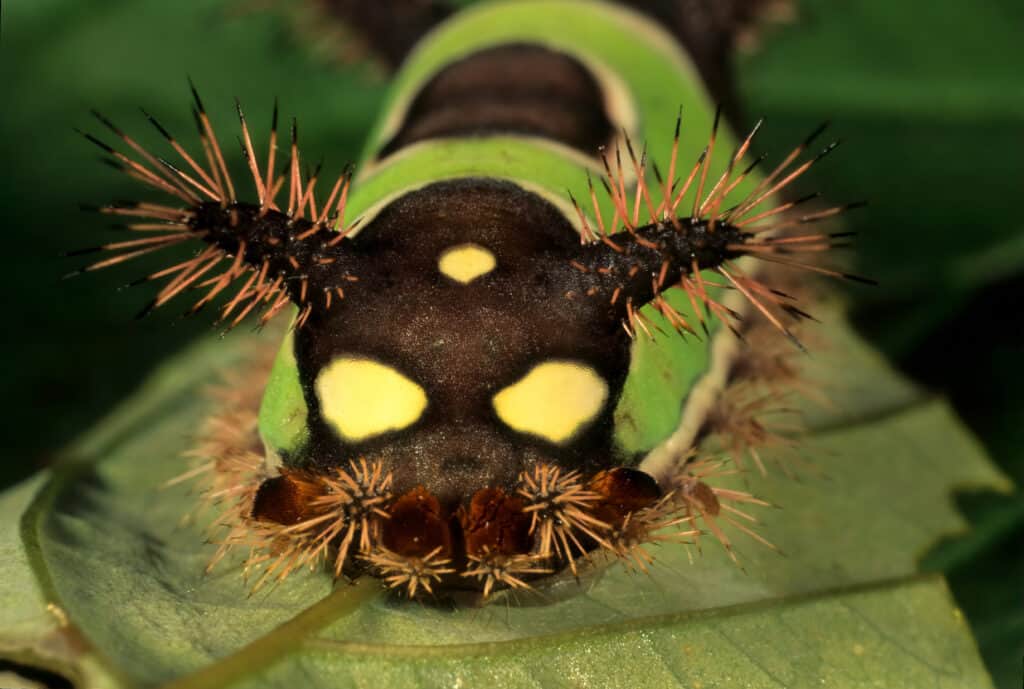
When zoomed in on, this caterpillar species looks like a horror movie monster. The saddleback caterpillar is a poisonous species, so avoid cuddling with it!
©Gerry Bishop/Shutterstock.com
Saddleback caterpillars are an easy-to-identify species in Indiana due to their unique appearance. This species has a green back with a centrally located brown dot encircled by white. Their bodies are brown at both ends, exhibiting a grainy texture, and decorated with pairs of horn-like protrusions. As larvae, they display a slug-like body shape and reach a length of one inch.
The diet of saddleback caterpillars is quite diverse, ranging from the leaves of maples and spicebush to sunflowers and more.
Caution is advised around these caterpillars as they are poisonous.
17. Skiff Slug Caterpillar (Prolimacodes badia)

With a green leaf-like appearance, the skiff caterpillar is named after its resemblance to a small upside-down boat.
©Jay Ondreicka/Shutterstock.com
The skiff caterpillar has a humped shape with two prominent ridges running from front to back, ending in a pronounced ‘tail.’ Each ridge is marked by a small, sharp hump at the top. When the caterpillar tucks its head into its body, and its legs aren’t visible, it bears a striking resemblance to a tiny overturned boat or ‘skiff.’
These caterpillars feed on various trees and shrubs, including American hophornbeam, beech, and sycamore, among others.
While other caterpillars from the slug family have clusters of spine-like hairs that can deliver a painful sting, the skiff caterpillar lacks these features, making it harmless.
18. Spiny Elm Caterpillar (Nymphalis antiopa)
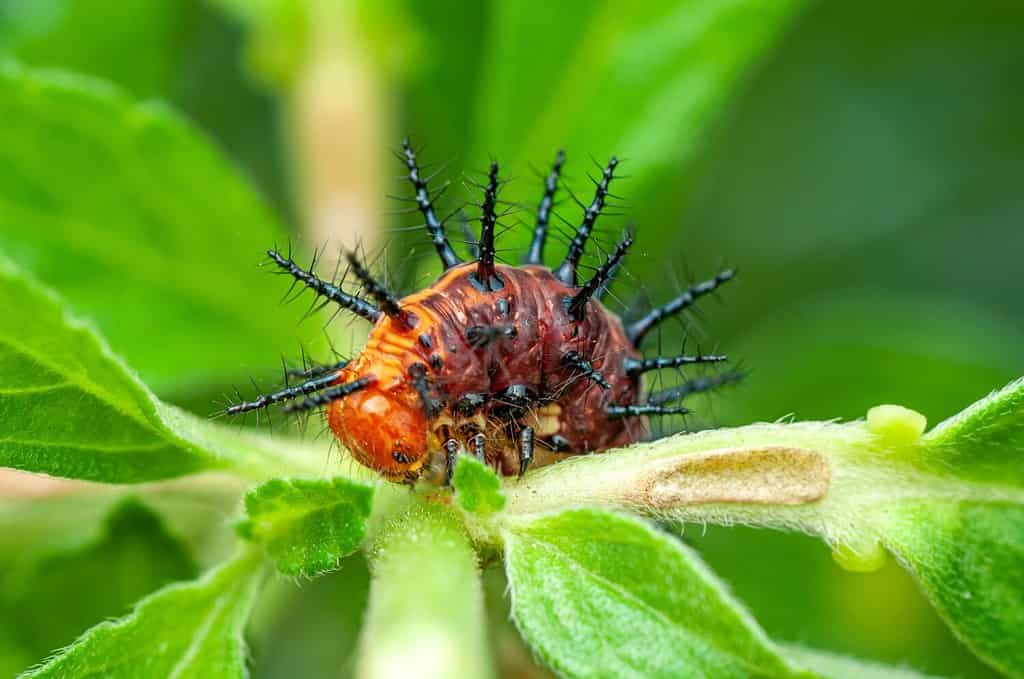
The spiny elm caterpillar is the larva of the mourning cloak butterfly species. Be warned, this species has HUGE spikes and is poisonous.
©CHONG LIANG YAN/Shutterstock.com
The spiny elm caterpillar is a sight to behold with its 2-inch long, black body peppered with minuscule white spots. It’s hard to miss the line of bold red dots tracing down its back, nestled between the thorny spines it’s named for.
These caterpillars enjoy a diet exclusively of elm tree leaves, as their name suggests.
Residents of Indiana typically encounter these caterpillars in springtime, though in certain areas, a second brood may appear later in the summer. It’s worth noting that this insect is indeed venomous.
19. Spiny Oak Slug Caterpillar (Euclea delphinii)
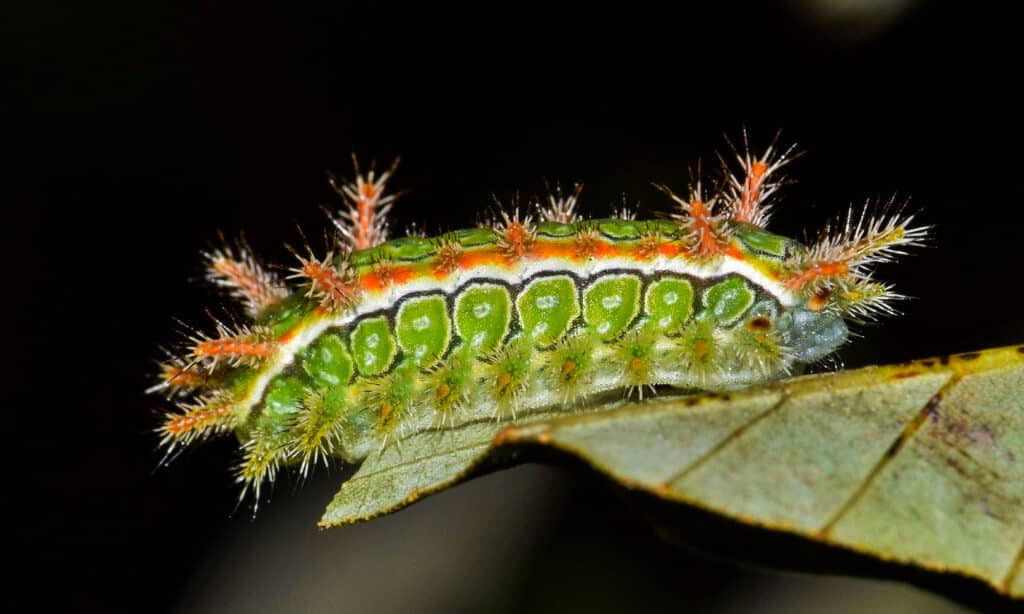
This venomous caterpillar has a beautiful bright coloration and is a common site in Indiana.
©iStock.com/Brett_Hondow
The spiny oak slug caterpillar, with its slug-like physique, presents an array of colors, including green, yellow, orange, and red. With a head that’s small and somewhat concealed, it’s distinguished by three pairs of large, bristle-tipped, horn-like spines on its front and two more pairs at its rear.
These caterpillars are known to dine on a variety of trees, such as oaks, apples, and maples, to name a few.
While the spiny oak slug caterpillar does have venomous spines, its sting is considered less severe compared to other stinging caterpillars.
20. Stinging Rose Caterpillar (Parasa indetermina)
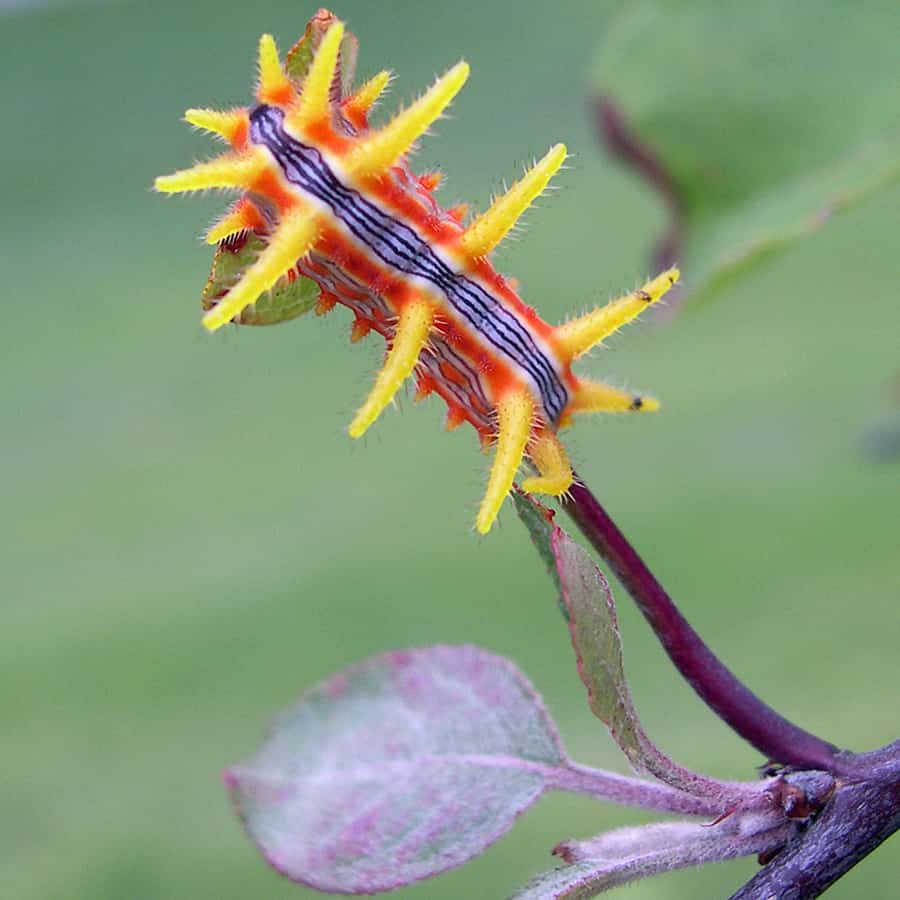
One of the most colorful caterpillar species in the world is the stinging rose caterpillar with its bright purple, red, orange, and yellow colors and large spines.
©M. Whitson / CC BY 4.0 – License
The stinging rose caterpillar exhibits red, orange, and yellow hues accented with purple and cream stripes. Measuring around an inch in length, it’s quite a small creature.
These caterpillars have a rather extensive dietary range, with apple, barberry, oak, paw paw, pear, and rose leaves on their menu. Despite the diversity in their food sources, they’re quite an uncommon species in Indiana.
The caterpillar comes equipped with seven pairs of horn-like structures covered in spines, as well as additional spiny bumps on its sides. Each spine is a hollow tube filled with fluid that can cause irritation. Contact with human skin can break the tip of these spines, releasing fluid and resulting in a painful sting.
Regions in Indiana with the Most Caterpillars
Let’s explore the regions in Indiana where you can find the highest populations of caterpillars:
- Hoosier National Forest: This expansive woodland, home to diverse plant species, is a haven for numerous caterpillars. The variety of trees provides plenty of food and shelter for these insects, making it a hotspot for caterpillar sightings.
- Northeastern Indiana Wetlands: The abundant plant life in these wetlands attracts a variety of caterpillars, who feast on the various grasses and plants available.
- Northwest & Westcentral Indiana Prairies: Prairies are a caterpillar’s paradise thanks to the vast array of flowering plants. These regions offer the perfect habitat for caterpillar species that favor open fields.
- Indiana Dunes National Park: The park’s unique blend of beach, woodland, and prairie ecosystems draws a diverse array of caterpillar species with their various dietary and environmental preferences.
Summary of Caterpillars Found in Indiana
| Number | Caterpillar | Type of Caterpillar | Poisonous? |
|---|---|---|---|
| 1 | Buck Moth Caterpillar | Moth | Yes |
| 2 | Cabbage Looper Caterpillar | Moth | No |
| 3 | Common Buckeye Caterpillar | Butterfly | No |
| 4 | Eastern Tiger Swallowtail Caterpillar | Butterfly | No |
| 5 | Fall Webworm Caterpillar | Moth | No |
| 6 | Forest Tent Caterpillar | Moth | No |
| 7 | Giant Leopard Moth Caterpillar | Moth | No |
| 8 | Gold Moth Caterpillar | Moth | No |
| 9 | Imperial Moth Caterpillar | Moth | No |
| 10 | Large Tolype Caterpillar | Moth | Yes |
| 11 | Luna Moth Caterpillar | Moth | No |
| 12 | Monarch Caterpillar | Butterfly | Yes |
| 13 | Monkey Slug Caterpillar | Moth | No |
| 14 | Pipevine Swallowtail Caterpillar | Butterfly | Yes |
| 15 | Puss Caterpillar | Moth | Yes |
| 16 | Saddleback Caterpillar | Moth | Yes |
| 17 | Skiff Slug Caterpillar | Moth | No |
| 18 | Spiny Elm Caterpillar | Butterfly | Yes |
| 19 | Spiny Oak Slug Caterpillar | Moth | Yes |
| 20 | Stinging Rose Caterpillar | Moth | Yes |
The photo featured at the top of this post is © Jay Ondreicka/Shutterstock.com
Thank you for reading! Have some feedback for us? Contact the AZ Animals editorial team.






